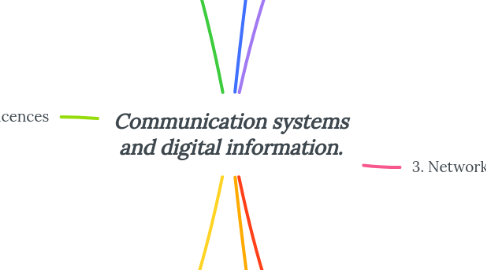
1. 6. The power of information
1.1. Finding information
1.1.1. Search engine
1.1.2. Hyperlinks
1.1.3. RSS
1.2. Managing information
1.2.1. Organising files
1.3. Sharing information
1.3.1. Horizontal social network
1.3.2. Vertical social network
1.4. Creating infotmatio
1.4.1. Web pages
1.4.2. Blogs
1.4.3. Wikis
2. 7. User licences
2.1. Open source
2.2. Closed source
2.3. Free
2.4. Propietary
2.5. Commercial
2.6. Freeware
2.7. Public domain
2.8. Trial
2.9. Demo
3. 8. Internet security measures
3.1. Privacy
3.2. Internet worms
3.3. Cyberbullying
3.4. Viruses
3.5. Http vs https control
3.6. Lost or stolen mobil phone
3.7. Phishing
3.8. Banners
3.9. Trojan horses
3.10. Botnet attacks
4. 1. Communication systems
4.1. Communication
4.1.1. The transmission of information from one place to another.
4.1.1.1. Analogue signal
4.1.1.2. Digital signal
4.2. Transmission protocol
4.2.1. A set of rules that all the devices in a communication system follow so that the can understand each other and exchange information.
5. 2. Wired and wireless communication.
5.1. Wired communication
5.1.1. Uses physical medial, such as wires or fibre optic cables.
5.2. Wireless communication
5.2.1. Takes place via the air, the ocean or space.
5.3. Digital devices
5.3.1. Hub
5.3.2. Switch
5.3.3. Router
5.3.4. Repeater
5.3.5. Ethernet network card
5.3.6. RJ45 connector
5.3.7. Infrared
5.3.8. Bluetooth
5.3.9. GPRS
6. 3. Networks
6.1. BAN
6.1.1. Body Area Network
6.2. PAN
6.2.1. Personal Area Network
6.3. LAN
6.3.1. Local Area Network
6.4. CAN
6.4.1. Campus Area Network
6.5. MAN
6.5.1. Metropolitan Area Network
6.6. WAN
6.6.1. Wide Area Network
6.7. SAN
6.7.1. Storage Area Network
7. 4. The internet
7.1. Standardisation of codes enables different devices.
7.2. ISP
7.2.1. Internet service providers
7.3. ID address
7.3.1. Consists of a series of numbers in four groups.
7.4. Domain names
7.4.1. Make it easier to identify a computer.
7.5. Domain name servers
7.6. TPC/IP protocol
7.6.1. TPC: This ensure successful transmission of data over the network.
7.6.2. IP: This transports data to the destination computer.
8. 5. Web evolution
8.1. WEB 1.0
8.1.1. read-only wed (1990-2000)
8.2. WEB 2.0
8.2.1. the social network (2001-2010)
8.3. WEB 3.0
8.3.1. the semantic web (since 2006)
8.4. Digital transformation
8.4.1. Involves the application of digital technology to areas of human activity to increase knowledge and make better decisions
